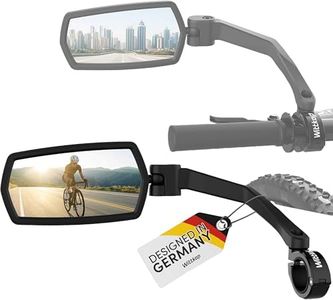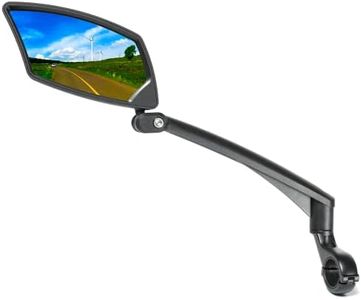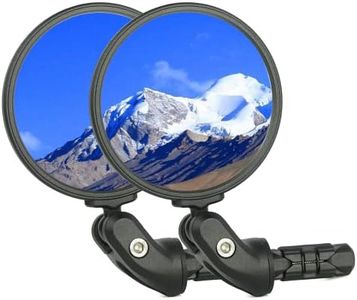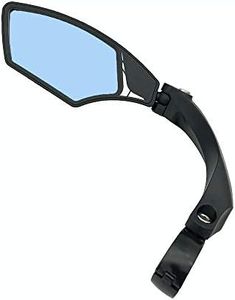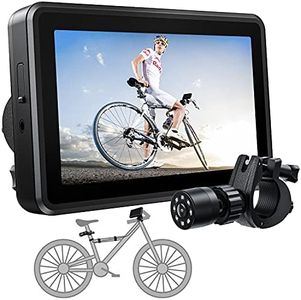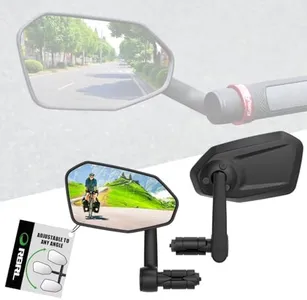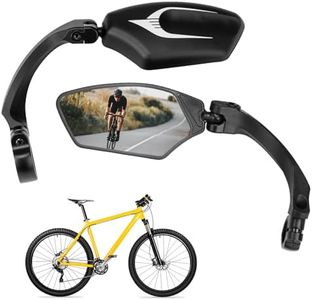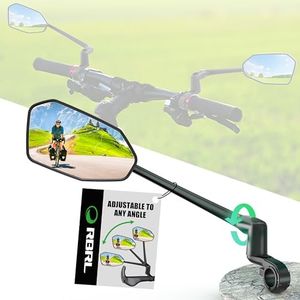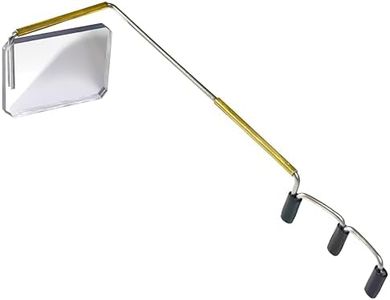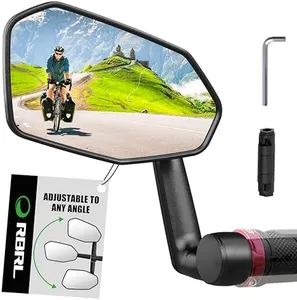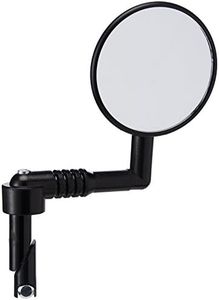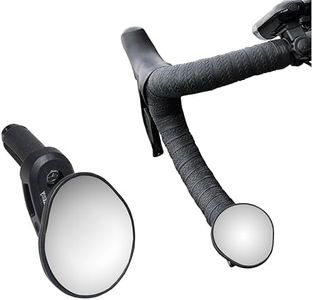10 Best Bike Mirrors 2025 in the United States
Our technology thoroughly searches through the online shopping world, reviewing hundreds of sites. We then process and analyze this information, updating in real-time to bring you the latest top-rated products. This way, you always get the best and most current options available.

Our Top Picks
Winner
BriskMore Handlebar Bike Mirror, Scratch Resistant Glass Lens, Ajustable And Rotatable Safe Rearview Bicycle Mirror for Left Side BT-016L
Most important from
2675 reviews
The BriskMore Handlebar Bike Mirror offers several advantages for cyclists needing a reliable rearview option. It features a high-definition convex glass lens that is both scratch-resistant and equipped with a shatterproof film, ensuring clear and sharp images. The mirror is 4.7x2.4 inches in size, providing a wide view behind you, which enhances safety on the road. The mirror is rotatable up to 360 degrees and adjustable up to 180 degrees, allowing for customizable viewing angles to suit your riding position and preferences.
This adjustability is a significant strength, making it versatile and practical for different types of bikes, including mountain bikes and e-bikes with flat handlebars within the range of 21-26mm in diameter. However, it’s important to note that this mirror is designed only for the left side and is not suitable for drop bar bikes, which could be a limitation for some users. The product is built with durable materials, including a PA6+30%GF frame, stainless steel screws, an aluminum alloy clamp, and a waterproof rubber ring, ensuring longevity and reliability.
Installation is straightforward with the included 4mm hex key, making it an easy process even for those who are not mechanically inclined. One potential downside is the weight; while not specified, the use of robust materials might make it slightly heavier compared to other mirrors. Additionally, while the product boasts a universal fit, it might require some users to make additional adjustments to fit their specific bike models. This mirror is a solid choice for cyclists looking for a durable, adjustable, and easy-to-install rearview mirror for their handlebars.
Most important from
2675 reviews
BriskMore Bike Handlebar Mirror,HD Glass Convex Lens Bicycle Rearview Mirror,Cycling Rear View Mirror, Adjustable Handlebar Wider View Bicycle Mirror for Scooter Road Mountain Bikes
Most important from
4240 reviews
The BriskMore Bike Handlebar Mirror is a solid choice for cyclists looking for enhanced rearview visibility. Its HD automotive grade convex glass offers a wide and clear view, crucial for safety. The mirror is quite adjustable with a 360-degree rotation and 180-degree tilt, allowing you to find the perfect angle easily. Measuring 76mm in diameter, it provides a larger field of view compared to many other bike mirrors. Durability is a significant advantage thanks to materials like PA6+30%GF and a high-impact frame, which are robust and reliable. The inclusion of a shatterproof film on the mirror adds an extra layer of safety.
Installation is user-friendly, aided by the included 4mm hex key, and the mirror fits a broad range of handlebar diameters (14-24mm), making it versatile for various bike types including road bikes, mountain bikes, and scooters. Weighing 190 grams, it is lightweight enough not to affect bike performance significantly. However, the universal fit might still require some adjustments, especially for non-standard handlebars.
While the shatterproof film and quality materials offer durability, they could make the mirror slightly pricier than simpler models. For those prioritizing clear visibility, adjustability, and durability, this mirror is a strong contender.
Most important from
4240 reviews
WITTKOP Bike mirror | Large HD field of vision | 360° rotatable & foldable | Mounting above & below | Break-proof & durable | ebike accessories, bike mirror handlebar mount, bicycle mirrors
Most important from
1633 reviews
The WITTKOP Bike Mirror is a well-rounded accessory designed to enhance your cycling experience, offering several notable features. Its large HD convex mirror provides a crystal-clear, wide field of vision, which is ideal for ensuring safety on the road. One of its standout features is the 360° rotatable and foldable design, allowing for complete adjustability to suit personal preferences and varying riding conditions. This level of customization makes it easy to find the perfect angle for optimal rear visibility.
The mirror is designed to be mounted on the left handlebar, and its robust construction, boasting over 20% reinforced materials, ensures durability and resistance to breaking, which is crucial for outdoor use. Additionally, the bike mirror is lightweight at 168 grams, so it won't add significant weight to your bike setup. Installation is straightforward and quick, with the necessary mounting setup included, allowing users to attach the mirror to the handlebars effortlessly using the supplied screw.
Backed by Wittkop's reputation for quality, stemming from their long history since 1898, the mirror promises reliable performance. However, it is important to note a couple of drawbacks. The mirror is specifically designed to mount on the left side only, which might limit its flexibility for some users. Also, weighing 168 grams, while not heavy, is slightly more than some ultra-lightweight options available. Despite these minor downsides, the WITTKOP Bike Mirror stands out for its clarity, adjustability, and ease of installation, making it a great choice for both regular cyclists and e-bike users looking to enhance their ride safety.
Most important from
1633 reviews
Buying Guide for the Best Bike Mirrors
Choosing the right bike mirror can significantly enhance your safety and riding experience. A bike mirror allows you to see what's behind you without having to turn your head, which can be crucial for avoiding accidents and staying aware of your surroundings. When selecting a bike mirror, consider the type of riding you do, the mirror's placement, and your personal preferences for size and adjustability. Here are some key specifications to help you make an informed decision.FAQ
Most Popular Categories Right Now
